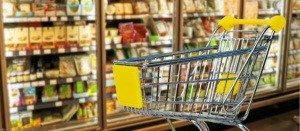
A product in a supermarket must speak for itself in order to tempt a customer to pick it up from a shelf
 As a married man and a father, I am forced to go grocery shopping at hypermarkets and supercenters, besides our regular friendly neighbourhood retailer, ‘Laxmi Stores’. In the case of a planned shopping trip accompanied with a list of items required, the choice is a nearby hypermarket or supermarket – the first choice being the supermarket for obvious reasons of a lesser crowd and shorter waiting line at the billing counter. Whereas for routine unplanned shopping and picking up daily required consumables the first choice is the neighbourhood retailer. The convenience of walk-in and walk-out, the all-time availability of required goods and the ready-to-help friendly behaviour of the owner makes this place appealing.
As a married man and a father, I am forced to go grocery shopping at hypermarkets and supercenters, besides our regular friendly neighbourhood retailer, ‘Laxmi Stores’. In the case of a planned shopping trip accompanied with a list of items required, the choice is a nearby hypermarket or supermarket – the first choice being the supermarket for obvious reasons of a lesser crowd and shorter waiting line at the billing counter. Whereas for routine unplanned shopping and picking up daily required consumables the first choice is the neighbourhood retailer. The convenience of walk-in and walk-out, the all-time availability of required goods and the ready-to-help friendly behaviour of the owner makes this place appealing.
When I am out shopping alone at the supermarket with no Customer Service Representatives around to assist me, there arises a difficulty in choosing certain products such as grains, pulses and cereals. To me, personally, it is quite confusing to distinguish between toor dal and channa dal, and this problem is almost always complicated because there are no signages put on shelves and racks indicating the product displayed. At times there is a tiny label with micro prints put on the packet of the grains and cereals that is hardly visible. The supermarket buys in bulk and repacks these goods in plastic bags in smaller quantities, and as an identifier puts a small partly printed and partly handwritten label which goes unnoticed many times. Can the supermarket make this more customer friendly by putting proper signages on the shelf and proper visible and legible labels on packets? Can the retailers make their products talk for themselves to the customers so that their movement from the shelf is enhanced? Can the visibility, availability, accessibility and display of products be improved to increase the customer’s basket size? I remember my days as a Marketing Executive with Cipla Ltd way back in 1992. Visiting retail chemist shops to develop a good rapport was part of the job. And whenever I visited the chemist shop, besides taking stock of the inventory position, I always looked out for the positioning of one of the products, Pirox Gel on the shelf of the chemist shop. Pirox Gel is a local application ointment for pain and spasm relief. Although it is a prescription product, it was sold as an all-purpose pain ointment and it was very effective. There were many competitors for this product and my objective was to make it a top-of-the-mind product for a majority of people and chemists alike. I insisted to all chemists that this product should be given a very prominent place in the store so that the patient standing at the counter could easily see the product and ask for it. Likewise, I wanted it to be the first choice of the chemist in the pain ointment. Many times I would go inside the store and make place for this product myself, sometimes it was not for the entire stock, but only for a display unit so that the visibility is ensured.
Indra Nooyi as chairman and CEO of PepsiCo, the world’s fourth-largest food and beverage company for 12 years, did visit the market and examine the pick-ability of its company’s products from the shelf. The display, the positioning on the shelf and off the shelf, the signages on the shelf, all mattered. When she visited the stores, she did not visit like a CEO, rather she went there as a customer, as a mother, and examined the attractiveness and temptation to pick up a product from the shelf, as a mother would do on a shopping round. She believed that the products should speak to the customers and persuade them to come closer, touch and carefully drop them in the basket. That is the importance of proper display and signages for making products speak for themselves.
Last week, I was on a planned shopping trail at a supermarket located in Porvorim, and this visit of mine was after six months, as mostly I preferred to shop at the friendly neighbourhood retailer or the popular hypermarket which is comparatively closer to my house. At the supermarket, I was very unhappy and dissatisfied as I noticed that there were no signages at most places, the price boards were not updated, the display was shabby, hygiene was compromised and the inventory was mixed up, with many items in short supply.
I had the opportunity to train the employees of this supermarket two years back on various aspects related to retail store management and customer service, and I had given all the necessary inputs to increase customer service and improve the visibility of products, which the store had been practising for a long time. The management had also reported a brisk increase in the sales and profitability post the training program. However of late, I believe, due to lack of interest among the management and employees, and no follow-ups, most of the lessons learnt during training program and practices put in action have been forgotten. I do not know the impact on their sales and profitability. However, for sure, I know that the footfalls have reduced to this supermarket, whereas the footfalls to the hypermarket, I referred to above, have increased manifold.
It is basic human nature to become complacent once you achieve some success in business and sales. All the best practices once followed, slowly start fading and the concentration shifts to the mundane tasks, which the management and employees alike feel are the most productive tasks. Businesses dealing in sales of goods should keep in mind that if they make their products visible and talk for themselves by way of good displays, proper signages, easy accessibility and all time availability, then they need not worry about the sales and the turnover from the shelf. It will happen automatically. Good display and signages not only help customers find what they’re looking for but also inspires them to want something they never knew they needed





